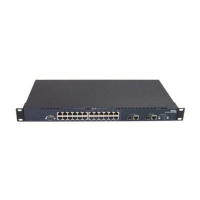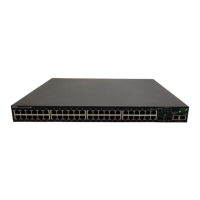BigIron RX Series Configuration Guide 447
53-1002253-01
Chapter
16
Topology Groups
Topology overview
This chapter describes the different types of topology groups and how to configure them. A topology
group is a named set of VLANs that share a Layer 2 control protocol. Topology groups simplify
configuration and enhance scalability of Layer 2 protocols by allowing you to run a single instance
of a Layer 2 protocol on multiple VLANs. One instance of the Layer 2 protocol controls all the VLANs.
For example, if a device is deployed in a Metro network and provides forwarding for two MRP rings
that each contain 128 VLANs, you can configure a topology group for each ring. If a link failure in a
ring causes a topology change, the change is applied to all the VLANs in the ring’s topology group.
Without topology groups, you would need to configure a separate ring for each VLAN.
You can use topology groups with the following Layer 2 protocols:
• STP
• MRP
• VSRP
• RSTP
Master VLAN and member VLANs
Each topology group contains a master VLAN and can contain one or more member VLANs and
VLAN groups:
• Master VLAN – The master VLAN contains the configuration information for the Layer 2
protocol. For example, if you plan to use the topology group for MRP, the topology group’s
master VLAN contains the ring configuration information.
• Member VLANs – The member VLANs are additional VLANs that share ports with the master
VLAN. The Layer 2 protocol settings for the ports in the master VLAN apply to the same ports in
the member VLANs. A change to the master VLAN’s Layer 2 protocol configuration or Layer 2
topology affects all the member VLANs. Member VLANs do not independently run a Layer 2
protocol.
• Member VLAN groups – A VLAN group is a named set of VLANs. The VLANs within a VLAN
group have the same ports and use the same values for other VLAN parameters.
When a Layer 2 topology change occurs on a port in the master VLAN, the same change is applied
to that port in all the member VLANs that contain the port. For example, if you configure a topology
group whose master VLAN contains ports 1/1 and 1/2, a Layer 2 state change on port 1/1 applies
to port 1/1 in all the member VLANs that contain that port. However, the state change does not
affect port 1/1 in VLANs that are not members of the topology group.

